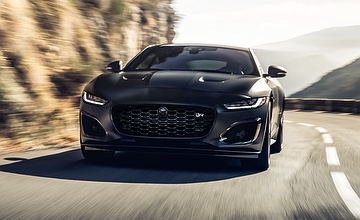2024 Jaguar F-Type R 75 Review

Overview
AFTER 28 years Jaguar is bidding farewell to the V8 engine, the 5.0-litre ‘AJ’ series unit signing off with the F-Type coupe and convertible range whose production has now also officially come to an end.
As Jaguar Land Rover moves at pace towards electrification, the beloved F-Type and its sonorous V8 are now committed to the history books – with new stocks of both Coupe and Convertible variants thin on the ground.
Priced from $183,200 plus on-road costs in ‘75’ format and $284,550 + ORC in R 75 guise (tested), the last F-Type Coupe series is an assertive and visceral final take on a recipe that dates to 2013 (in its original form). The Convertible is available from $188,450 + ORC.
All ‘75’ grades are characterised by 20-inch wheels with unique wheel centres, bespoke badging, LED lighting, and quad exhaust tips with their own subtle branding. The cockpit features a 12.3-inch configurable instrument panel, deployable air vents, ‘75’ or ‘R 75’ motifs, interior Black Pack, and ergonomic seats with heating and cooling.
The F-Type is suspended by a double-wishbone arrangement front and rear and coupled with exquisite electric power assisted steering and torque vectoring brake systems “fundamental to the car’s immediate and intuitive responses to every driver input,” says Jaguar.
The chassis of the ‘75’ duo is enhanced by rear knuckles made from aluminium which combined with larger wheel bearings to deliver what Jaguar says its “absolute precision of the tyre contact patch”.
Revised upper ball joints feature on the R 75 to increase camber and toe stiffness, while both feature an electronic active differential to further optimise traction. Adaptive damping, a torque-on-demand all-wheel drive system, and configurable damping, steering, throttle and gearshift response settings also feature.
The R 75 may also be specified with Jaguar’s Carbon Ceramic Matrix brake rotors measuring a monstrous 398mm at the front and 380mm in the rear. The duo is clamped by six- and four piston monobloc callipers respectively with a distinctive yellow finish.
Under that long clamshell bonnet is Jaguar’s renowned 5.0-litre supercharged V8 with its standard Quickshift eight-speed automatic transmission. Power and torque numbers are listed at 423kW and 700Nm, or sufficient for accelerating 0-100km/h in 3.7 seconds.
Top speed is electronically capped at 285km/h.
Each engine is paired with a switchable active exhaust system allowing the F-Type’s distinctive V8 bark and characteristic overrun crackle.
Driving Impressions
It’s tough to say goodbye to a car that has reached the end of its time – especially when it’s as good as Jaguar’s F-Type.
Though it might be getting long in the tooth, the F-Type remains a fine example of its kind, exhibiting the type of character and style that only a British marque can deliver, while at the same time offering generous servings of soaring V8 power.
The metallic rasp of that snarling 5.0-litre mill is raucous, and highly theatrical. At higher engine speeds it urges you to open the taps ever further, launching itself at the horizon with an eagerness that doesn’t seem to diminish; lest you wish to risk your licence.
The precision of the gear shifts and the playfulness of the F-Type’s obviously rear-biased driveline recall a time when it was possible to ‘chirp’ the tyres on upshift. There’s just enough attitude to remind you the Jag means business – but it’s by no means a handful.
If you grew up punting towering V8s, the F-Type will feel familiar; almost as a reminder of a time now coming to close. But unlike most of the V8-powered cars of our youth, the F-Type is remarkably sharp, dare we say even accurate.
The long bonnet points effortlessly into sweeping bends, providing resolute feedback through a well-weighted ‘wheel. The ride is calm, but not compliant. It’s tuned to manage imperfections, rather than mask them, favouring grip over gratification in the way a true sports car should.
Richly upholstered, cossetting bucket seats and a legs-out driving position suit the F-Type’s rear-set cabin and provide a garrulous interpretation of rubber on road; even if the associated thrum of the 295 section hoops has a habit of getting on your goat.
Excusing the tyre roar, the F-Type cabin is pleasant, if a little dated. Its technological interface is somewhat slow to inputs and the readouts cumbrous when viewed against more modern JLR products. Yet, it all works as expected – the conspicuousness of the switchgear a welcome reminder of a time when hard buttons and touchscreens coexisted in harmony.
The Jaguar F-Type R 75 might be the last of a breed, and will no doubt give way to faster, quieter, and arguably less enthralling SUV-shaped sports cars to come. But we doubt any will match Jaguar’s trademark pace and grace (we can’t say it’s spacious, sorry) in the way this mighty modern classic can.
It’s a sad realisation we’re all about to face. The F-Type will be missed.